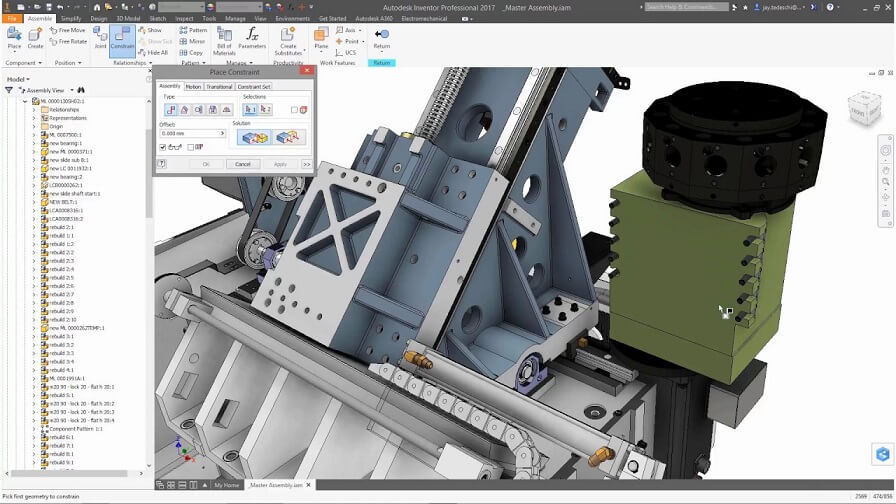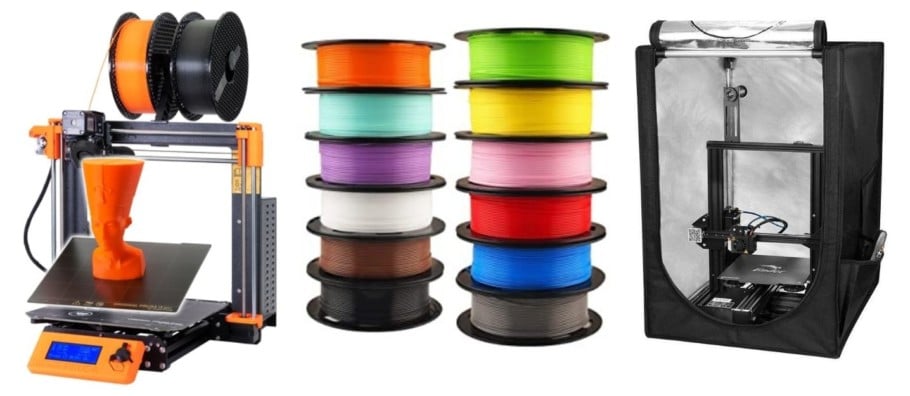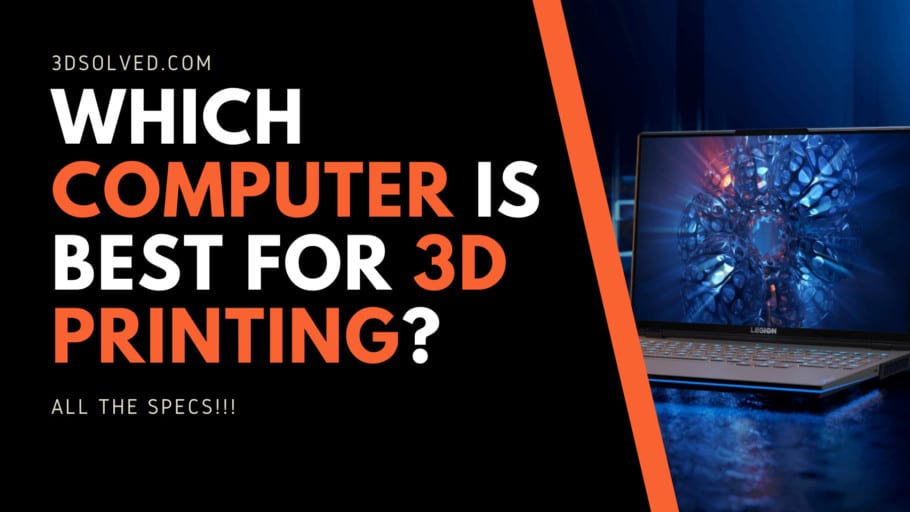There is a lot of talk around the type of computer that is required to successfully run a 3d printing operation. Much of this debate is based on the (false) idea that all 3D-related fields do need considerable processing power.
You may be interested in getting your hands on your first 3D printer but before doing so, you might wonder if your current PC or Laptop is enough for this new hobby.
3D printing does not require an expensive PC or Laptop with lots of processing power. For most users, a computer with 8GB of ram, a 4 core Intel i5 or Ryzen comparable processor, and a few gigabytes of available storage space will be enough.
The only case in which a better setup is recommended is for users that also want to design their own objects since 3D CAD software tends to be resource-intensive.
Although I go into further detail and answer other questions in this article, the following table should be useful!
| 3D Printing | 3D Printing | 3D Printing | 3d Modeling | 3d Modeling | 3d Modeling | |
| Budget | Low | Medium | High | Low | Medium | High |
| Processor | 2 cores i3 | 4 cores i5 | 6 cores i7 | 4 cores i5 | 6 cores i7 | 8 cores i7 |
| Ram | 4GB | 8GB | 16GB | 8GB | 16GB | 32GB |
| Graphics Card | NO | NO | NO | NO | NVIDIA 1650ti | NVIDIA 3060ti |
| Hard Drive | 128GB | 512GB | 1TB | 512GB | 1TB | 2TB |
What type of computer do you need for 3d printing?
3D printing is not inherently processing power-intensive, so a regular PC or laptop should be enough for most use cases. If you only plan on using the computer for slicing, you should not worry about this issue and just go with the computer that is available to you.
Most 3d printing enthusiasts only use their computers to store files and “translating” them into G-Code (“slicing”). Users that do require a powerful and somewhat expensive computer are those that are interested in also modeling their own objects.
Because of the fact that 3D CAD modeling is resource-intensive, a better computer will be required. Although a graphics card is also recommended, a budget GPU like NVIDIA’s 1650ti is more than enough. Expensive cards are only necessary for rendering scenes, which is unrelated to 3d printing.
Computer requirements for 3d printing
| Specifications | |
| Processor | 4 cores i5 |
| Ram | 8GB |
| Graphics Card | Not necessary |
| Hard Drive | 512GB |
A budget computer with 8GB of ram and an Intel or AMD processor with 2 cores should be more than enough for comfortably using any slicer, aka the software that converts a 3d file into machine instructions). In fact, you could also use a cheaper computer, but some features could run slow when dealing with more complex objects (and thus larger files).
Take Ultimaker’s Cura as an example: the developers state that only 4GB of ram and a single-core processor are required to run the slicer. Being a user of that app myself, I would recommend installing the slicer on a slightly better computer. Other similar programs like Simplify3D and PrusaSlicer all have similar requirements. I would recommend aiming at the recommendations that I listed above and not just the bare minimum required by the developers.
Example of useful 3D printing computer: Business PC (All business PC’s are more than enough).
Do you need a graphics card for 3d printing?
A graphics card is not required for 3d printing comfortably and having a good user experience. It is often thought that all 3d related fields require expensive computers, but 3d printing deals with a reduced amount of objects at the same time, all of which have no textures.
A graphics card would only slightly increase the processing times of a slicer when dealing with very large files that have a huge amount of details in high resolution.
How good of a computer do you need for 3d modelling?

When it comes to 3d CAD modeling, a somewhat powerful computer is required. This is mostly due to the fact that modeling programs are resource-intensive and perform an enormous amount of parallel computations per second.
Unless you are designing simple shapes with little to no details and definition, the usability of these apps will be heavily affected by the lack of resources of the computer.
Keep in mind that if you are just getting started with 3d modeling, you will most probably only be able to create simple objects. Due to this, a budget PC or laptop is also going to be enough to start learning and figure out if a more robust setup is justified for you.
Computer requirements for 3d CAD modelling
| Specifications | |
| Processor | 6 cores i7 |
| Ram | 16GB |
| Graphics Card | NVIDIA 1650ti |
| Hard Drive | 1TB |
Since 3D CAD modeling does require some computing capabilities, you should aim at a computer with at least 16GB of ram, an Intel i5 or Ryzen comparable processor, and a budget NVIDIA or AMD graphics card. An NVIDIA 1650ti or the comparable AMD Radeon 5500XT are going to exceed the expectations of all beginner and intermediate modelers.
Since the requirements stated almost everywhere are always really the bare minimum, I should clarify that the specifications I listed above do not follow that convention. My goal is to recommend a setup that is going to be enjoyable to use in the years to come.
Example of useful 3D modelling computer: Gaming PC (Gaming PC’s have everything you need for 3D modelling).
Frequently asked questions
Can you use a 3d printer with a laptop?
A Laptop is more than enough for 99% of possible use cases related to 3d printing. Keep in mind that, much like with PCs, laptops also come in a wide range of prices. Regardless of that, a budget laptop of no more than $500 is going to exceed all the requirements posed by 3d printing-related programs (excluding 3d modeling).
Affordable Laptop Example: Lenovo IdeaPad.
Is it possible to 3d print without a computer?
It is not necessary to have a computer in order to use a 3d printer. This is due to the fact that almost all 3d printers have an SD card reader that is used to read files and start printing them. If you already have an SD card with your files stored in it, a computer is no longer necessary to use the printer.
Having said that, in the off case that you don’t already own a computer, I would definitely recommend getting one before getting your hands on a 3d printer. It’s just a matter of priorities…
What software do you need for 3d printing?
The only required software for being able to 3d print an object of your choosing is a slicer. This is the program that takes a 3d object, normally saved as an STL file, and translates it into commands that can be understood by any 3D printer (G-Code). The most popular slicers are Cura (free), PrusaSlicer (free), and Simplify3D (paid).
In addition to a slicer, you can also benefit from installing modeling, mesh repair, and printer management applications.
Modeling software, formally known as 3D CAD software, is used by designers to create custom-made objects. Unless you learn the basics of one of these programs, you will only be able to print objects that other people designed and shared. There are very simple apps for beginners like Tinkercad (our review) and more advanced and feature-rich programs like Fusion 360 (our review) or SolidWorks (our review)
Mesh Repair programs are used to repair a file that, due to a wide number of possible reasons, is not being properly sliced. Tools such as Meshmixer, Netfabb, and Meshlab are used in these cases.
Last but not least, print management tools are used to control multiple printers simultaneously without the need to be physically close to the machines. Examples of these tools are OctoPrint, AstroPrint, and Repetir, among others.
Which operating system is best for 3d printing?
When it comes to 3d printing, the choice of the operating system of your computer is completely irrelevant. Cura, PrusaSlicer, and Simplify 3d (the most popular slicers) are all compatible with Windows, macOS, and Linux.
Which operating system is best for 3d modeling?
For 3D CAD modeling, both MacOs and Windows are excellent choices. It used to be the case that Apple’s operating system was the default choice for designers, but this has changed in the last couple of years.
All popular programs offer versions for both operating systems. Such is the case for Fusion360 (our review), ZBrush, Blender (our review), and many others.
The list of available modeling software for Linux is more limited. Although some developers do offer Linux compatible releases, the community of designers using this OS is smaller, which means that you may have to solve the issues you encounter by yourself.
Conclusion
Having gone through more than enough things to consider when deciding about which PC or Laptop is best for 3d printing, we can conclude that almost any decent computer will comfortably exceed most requirements.
As we saw, 3d printing is not very taxing in terms of computing power, and most likely than not, your current setup is going to be enough for this new hobby of yours. The only case in which you should be interested in getting your hands on a better computer is if you also want to design your own 3d objects.
Check out our recommended products section

We created a recommended products section that will allow you to remove the guesswork and reduce the time spent researching what printer, filament, or upgrades to get, since we know that this can be a very daunting task and which generally leads to a lot of confusion.
We have selected just a handful of 3D printers that we consider to be good for beginners as well as intermediates, and even experts, making the decision easier, and the filaments, as well as the upgrades listed, were all tested by us and carefully selected, so you know that whichever one you choose will work as intended.
Error processing API data.

Parts of this post are lacking for sure. The video card is the most important piece of a 3D modeling computer. No matter which processor you have on your MB or how much ram you have. If you can not update the open GL on your video you will not be able to use any of the mesh repair programs such as meshmixer and meshlab. If you have less than 2gb of video memory you are in trouble as far as 3D modeling is concerned. If your MB has any kind of legacy video on board you are screwed. The video card companies are not going to help you because it is not in their best interest. Which is why updateing the control software for these cards is a nightmare with the best of luck. Most on board video will not even try to update. PERIOD. Bare minimum if you are really interested in 3D is a quad core i7 with 16gb RAM and a 4gb video card with at least ddr5 memory. Which will cost more than the computer itself. IF YOU CAN FIND ONE, that isn’t a faiure waiting to happen. So you are right a middle to high end gaming machine is bare minimum you can get away with. Then there is all the glitches that come with windows. Even if you get your computer perfectly set up so all your software works flawlessly you will more than likely be screwed tomorrow morning when you find that windows update automaticly destroyed all your work and there is nothing you can do about it. And they are proud of the fact they are capable of that. So you are looking at a possible 3D machine for around $2500.00 if it has a 4gb video card. And thats a cheap card not a top line wich can cost $1500 to $3000 by itself. EACH some of these machines have four video card slots. So you can scratch around and try to work with 3D with the average machines listed in the article or you can be sure its going to handle it and get a high end game machine for thousands of dollars and pray that windows does not make it a doorstop with the next update. JMHO based on everyday dealing with it.